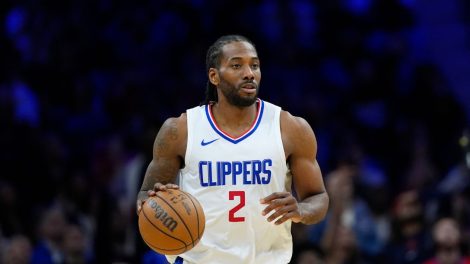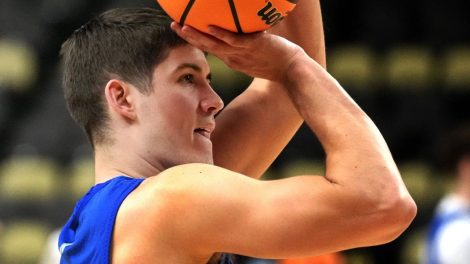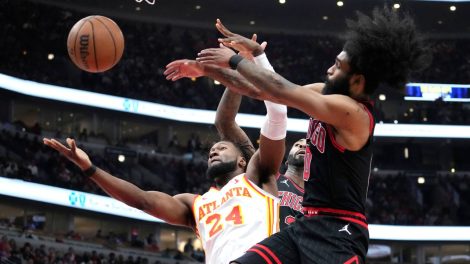With the NBA’s free-agent moratorium just four days away – beginning at 6:00 p.m. ET on June 30 – you no doubt have been bombarded with a series of terms and phrases you might not completely understand.
As such, to get you ready for yet another NBA off-season that promises to be as nutty as ever, here’s a handy little FAQ that we’ve put together to help you better navigate the waters ahead.
NOTE: All collective bargaining agreement details are sourced from Larry Coon’s CBA FAQ.
NBA off-season key dates
Before diving into the nitty-gritty of things, here are some key dates to keep in mind for the coming NBA summer.
June 30: Start of the NBA’s free-agent moratorium period at 6:00 p.m. ET
July 1–3: Salt Lake City Summer League and California Classic Summer League
July 5–15: MGM Resorts Las Vegas NBA Summer League
July 6: End of moratorium period at 12:00 p.m. ET
Aug. 31–Sept. 15: 2019 FIBA Basketball World Cup
Late September: Start of NBA training camps
What is the moratorium period and why can a deal not be made official until July 6?
The moratorium period was first established in 1999 to give teams equal opportunity to pursue free agents and prevent under-the-table deals agreed upon before the start of free agency.
As such, any deal that you hear about during this period can’t be made official until July 6, or just about a full week after the start of the period.
This year, the NBA moved up the start of the moratorium period to June 30 at 6:00 p.m. ET instead of July 1 at 12:00 a.m. ET in order to make a primetime television show out of it.
There’s sure to be a lot of rumour-mongering as soon as the moratorium opens, but whether we’ll hear about big names on the move or not immediately is up for debate as the biggest free agents usually take meetings with select teams before coming a decision. This can hold up the market as teams wait on first-tier free-agent decisions before moving on to second- and third-tier options.
What is a max contract and how is it determined? How does it differ from a “super max”?
Put simply, a max contract is exactly what it sounds like: A contract signed that will give the player the maximum amount of money he is allowed under the rules of the collective bargaining agreement.
Where things start to get a little more complicated, however, is the “allowed under the rules of the CBA” part of that definition.
There are three tiers of max salaries that a player is eligible for determined by service time. Take a look at this table below to see how it breaks down (with salary information using the projected $109-million salary cap for the 2019–20 season).
| Years in NBA | Eligible Max Starting Salary | 2019-20 Salary (estimate) |
|---|---|---|
| 0-6 | 25% of salary cap | $27.25 million |
| 7-9 | 30% of salary cap | $32.7 million |
| 10+ | 35% of salary cap | $38.15 million |
An important thing to take note of here is the title of that second column: “eligible max starting salary.”
The reason we specifically mention “starting salary” is because max salaries are tied to the salary cap only in the first year of the deal. For multi-year deals, players will still receive raises year-over-year, with those raises connected to the initial value – usually up to five per cent, with a maximum of eight per cent in special cases such as when a team uses the Larry Bird exception to re-sign a player (more on this in the next question).
And in regards to a “super max” contract, the actual name of this deal is called the “designated veteran extension/contract,” with “super max” just its nickname.
Essentially, this kind of deal gives players in that 30-per-cent-of-the-cap tier an opportunity to leapfrog straight into the 35-per-cent range without needing to have played in the league for 10 years – provided that player meets certain steep criteria.
First of all, beyond anything else, a player can only qualify as a “designated veteran player” if they meet one of the following criteria, per Larry Coon’s CBA FAQ:
• The player was named to the All-NBA First, Second or Third team in the most recent season, or both of the two seasons that preceded the most recent season.
• The player was named the Defensive Player of the Year in the most recent season, or both of the two seasons that preceded the most recent season.
• The player was named the NBA Most Valuable Player in any of the three most recent seasons.
So, for example, Charlotte Hornets unrestricted free agent Kemba Walker is eligible for a “super max” deal because he made an All-NBA team this year and because of his service time logged with the Hornets.
Walker just finished his eighth season in the NBA making him just qualified for the designated veteran contract – a player needs to have finished eight or nine seasons in the NBA continuously with the team who had his rookie contract.
And had Walker made an All-NBA team last season, he could’ve been in line for the designated veteran extension, a contract extension that still allows a player that meets that criteria you see above leap into the 35-per-cent tier like the contract, but with seven or eight years of service time instead of eight or nine.
So the big difference between the extension and the contract is that a player could potentially be eligible for the extension sooner. [sidebar]
Lastly on the “super max,” this kind of salary-tier jumping isn’t just possible to more seasoned players, there’s also one that’s formally called the “5th year, 30% max criteria” that’s available to players about to come off their rookie scale deal that’s more commonly referred to as the “Derrick Rose Rule.”
More specifically, this Derrick Rose Rule is an addendum to something called the “designated rookie extension/free agent contract after rookie scale contract.”
In normal circumstances, a player on a rookie scale contract who’s entering his fourth year will be up for an extension worth up to 25 per cent of the cap in the first year of that deal. But, like with a designated veteran extension, if a player meets any one of those lofty goals you can refer to above (like Rose did winning MVP in 2011) that player would then be eligible to sign an extension to jump him into the 30-per-cent tier earlier than normal.
What are Bird rights?
Among the most common sources of confusion, in order to understand what “Bird rights” are is to first understand how exceptions work in the NBA.
An exception is a mechanism in a soft-cap system, such as the NBA’s CBA, that allow teams to function and still make moves even while above the salary cap. The term “Bird rights” comes from the “Larry Bird Exception.”
Obviously named after the legendary Boston Celtics forward, there are three kinds of Bird exceptions: The regular “Larry Bird exception,” the “early Bird exception” and the “non-Bird exception.”
For simplicity’s sake, we’ll only focus on the regular “Larry Bird exception” because this is where the term “Bird rights” actually comes from.
This exception allows a team to exceed the salary cap to re-sign their own free agents, provided they own that player’s “Bird rights.” In order for a team to own a player’s Bird rights, that player must play three seasons for that team without clearing waivers or changing teams as a free agent. It doesn’t matter if a player signed a three-year deal or three separate one-year deals — as long as he remains with the team for three seasons, a team will then have his Bird rights.
Adding to this, when a player with Bird rights gets traded, those Bird rights get traded with him.
For example, the Toronto Raptors traded for Kawhi Leonard last July and now own his Bird rights as they transferred over with him when he was dealt.
This provides the Raptors with a number of advantages to try to retain Leonard over any other team because with Leonard’s Bird rights in hand, the Raptors can offer an additional year of maximum term (five years total instead of only four with a team who doesn’t own his Bird rights) and, perhaps more importantly, higher annual raises.
The standard maximum year-over-year raise an NBA team can offer on a free-agent contract is five per cent, but when using the Larry Bird exception to re-sign a player, a team can offer up to eight per cent raises.
This is why the Raptors can offer Leonard a five-year, $190-million contract. With a salary-cap projection of $109 million for the 2019–20 season, Leonard would earn $32.7 million in the first year of his contract and then see annual raises of about $2.6 million (eight per cent of $32.7 million) every year over the previous year’s salary.
What are player options, club options and qualifying offers? How do they work?
Here’s a look at each one of these “options clauses,” individually:
Team option: Also known as a “club option,” this generally gives the team control over the final year of the contract. For example, if a player signs a three-year deal with a team option on the third year, it’s up to the team decide to pick it up and move forward with the player.
There can normally only be one option year, but there’s a special exception for rookie scale contracts, which features club options on the third and fourth years of those deals.
Player option: Like the name suggests, this gives the player the right to invoke the option. Using the Raptors again as an example, both Leonard and Marc Gasol have player options and will be owed the money that’s left on their respective contracts if they choose to exercise the option. If not, however, they will become unrestricted free agents.
This is why there’s been so much chatter with Leonard’s free agency. It’s been reported that he will decline the player option and test the open market.
Like the team option, there can only be one option year attached to a contract (with no special circumstances for player options like there are with team options in a rookie scale contract).
Qualifying offer: This isn’t an option clause, but we’ll talk about it anyway as it’s somewhat similar.
A qualifying offer is a mechanism that allows a team to make their free agent a restricted free agent and is a standing offer for a one-year guaranteed contract.
If a player is a restricted free agent, this means the team he’s currently on holds the right to keep the player by matching any contract he might sign with another team.
The most common occurrence of restricted free agency comes with players entering the fifth year of their rookie scale contracts, provided they don’t sign a contract extension before this. For example, the Raptors’ Pascal Siakam is projected to have a qualifying offer worth about $3.5 million in the summer of 2020 – if he doesn’t sign a contract extension with the Raptors this summer, that is.
Player early termination option: Finally, there’s one other kind of option clause — a player early termination option (ETO). This functions exactly as it sounds, it allows a player to terminate a contract early.
This is pretty similar to a player option, but it comes with less stability for the player to exercise his option to remain with a club in the event unrestricted free agency may not be as enticing an option as it first seemed when the contract was first signed.
What is the salary cap? How does the luxury tax work?
For more detailed information on the coming season’s salary cap and luxury tax please refer to this post from earlier in the week.
[relatedlinks]








